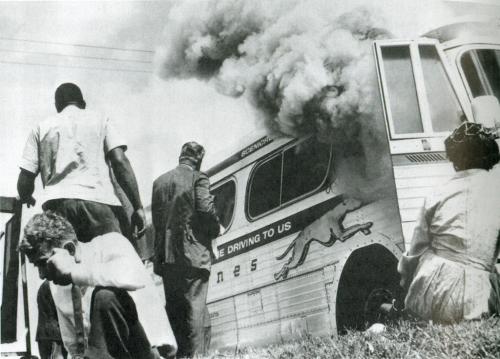Have you heard of the Freedom Riders?

On May 4, 2011, we celebrate the 50th anniversary of the Freedom Riders. On that day in 1961, 13 people boarded a bus in Washington, D.C. and began their journey to New Orleans. The interracial group of men and women, many of them in their 20’s, set out to test a court ruling* of 1960 that outlawed segregation in public transportation.
Although the armed forces were integrated in 1948 and “separate but equal” public schools for blacks and whites were found unconstitutional in 1954, segregation in the South continued to be a way of life. Train stations and bus terminals had separate water fountains, restrooms and lunch counters.
The Congress of Racial Equality, a civil rights organization, sponsored the Freedom Riders. Their mission was to travel through southern states and test local laws and customs. Specifically, they set out to be served in the whites-only area of bus terminals. If served, they would know that the desegregation ruling was being followed. If denied service and arrested, they would go to jail without resisting. The Riders were prepared for violence and planned to respond with non-violence. Many of the Riders filled out their wills before leaving on the trip, realizing they may not return. If necessary, the federal government would have to step in and enforce the law.
The first week on the road was uneventful. The Riders were served at most bus stations in Virginia, North and South Carolina. Then on the 11th day in Alabama, they were met with rocks and a firebomb. They were beaten by an angry mob as they stepped off the bus. A second bus was met by a Ku Klux Klan mob who likewise attacked the passengers.
Unable to find a bus driver to go any further, the group flew from Birmingham, Alabama to New Orleans. They were joined by a second group of college students from Tennessee. That group had staged similar sit-ins at lunch counters in the South. Throughout the summer, hundreds of supporters participated in these demonstrations. Several hundred were arrested and jailed for weeks at a time. The freedom rides attracted approximately 600 people before it ended in the fall. It took three more years before Congress outlawed segregation and discrimination against blacks nationwide.**
*Boynton vs. Virginia, 364 U.S. 454 (1960); this decision upheld an earlier decision by the Supreme Court, Morgan v. Commonwealth of Virginia (328 U.S. 373, 1946) that was essentially ignored in the South. Irene Morgan, a 27-year-old African American woman refused to give up her seat to a white passenger on an interstate bus in 1944. She was arrested and jailed. This happened eleven years before Rosa Parks staged her sit-in on a bus in 1955. Irene passed away at age 90 in 2007.
**The Civil Rights Act of 1964 and the Voting Rights Act of 1965 that eliminated obstacles to black voter registrations.
Alert: On May 16, 2011, a PBS documentary called “Freedom Riders” will air in the evening. Check your local listings for the time. Parts of it were shown on the Oprah Winfrey show in early May and it’s an excellent and highly recommended film.




The Freedom Riders of 1961 are heroes of modern American history. It is too bad that those 13 passengers do not receive more credit from the historians and the members of media for their courage.